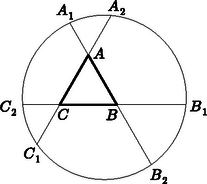| Cím: | Dániel Arany Competition in Mathematics, 2001/2002 | ||
| Füzet: | 2003/októberi melléklet, 19 - 21. oldal |  PDF | MathML PDF | MathML |
|
| Témakör(ök): | Arany Dániel | ||
|
A szöveg csak Firefox böngészőben jelenik meg helyesen. Használja a fenti PDF file-ra mutató link-et a letöltésre. Second round 1. Solve the following simultaneous equations on the set of integers: 2. In a right-angled triangle of legs and , the altitude drawn to the hypotenuse equals one fourth of the hypotenuse. Evaluate 3. Prove that if 4. The diagonals and of a convex quadrilateral are perpendicular. From the midpoint of side , drop a perpendicular onto the line of side . Let denote the foot of the perpendicular. From the midpoint of side , drop a perpendicular onto the line of side and denote its foot by . Prove that the lines and intersect on the line of diagonal . Third round (final) 1. How many -digit positive integers are there (in base 10), the sum of whose digits is , where is a positive integer? 2. In a triangle , . The perpendicular bisectors of side and side intersect the line of the altitude drawn from vertex at the points and , respectively. Determine the largest angle of the triangle, given that . 3. Consider the sequence . One may rearrange the sequence as follows: It is allowed to put the last number in any of the 1st, 2nd, 3rd, , 2002nd places, provided that the number moved forward from the end never precedes a greater number than itself. The same procedure can be applied to the new sequence and repeated as long as it is possible. Prove that after each step, one of the th and the th terms of the sequence thus obtained will be even and the other will be odd, for all . Schools with advanced mathematics programme 1. Prove that if 2. A square of side is rotated about its centre, and thus a new square is obtained. The common part of the two squares is an equilateral octagon of side . Express the area of the octagon in terms of and . Prove that 3. The lines of the sides of an equilateral triangle in the interior of a circle intersect the circle at the points , , , , , as follows: The intersections of line with the circle are and , the intersections of are and , and the intersections of are and , as shown in the Figure.  Prove that 4. Given that the sum of 121 positive integers is 360, prove that it is possible to select some numbers out of the 121, such that their sum is 120. Second (final) round 1. Prove that no matter what positive integer the base of the number system is, it is always true that if the ratio of the number to is 2 then . 2. is a point inside or on the boundary of a regular polygon with sides. Let 3. microchips can test one another as follows: If any two are connected, each of them will display whether the other is good or faulty. A good chip will always answer correctly while a faulty chip will give a random answer. Given that more than half of the chips are good, is it possible to select a good chip with certainty in less than trials? |